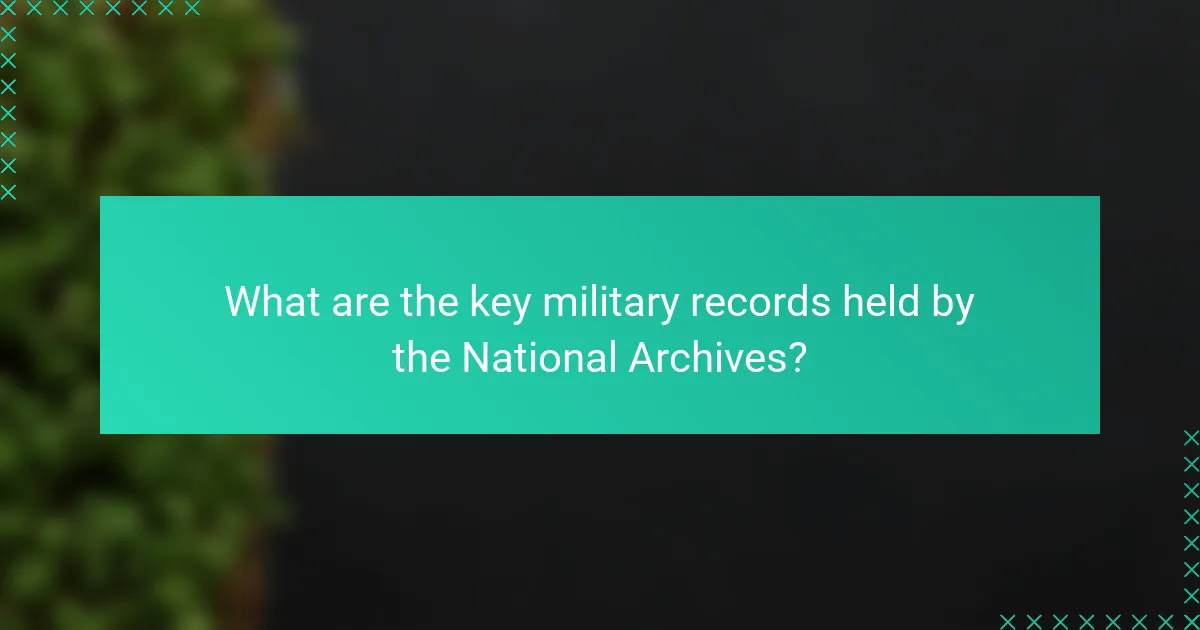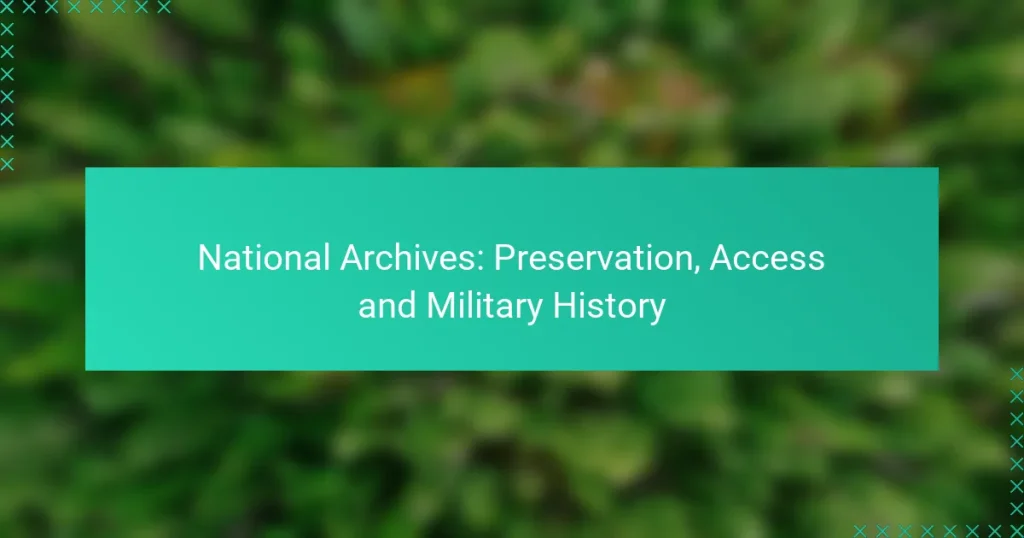The National Archives plays a vital role in preserving military history through advanced archival storage and digital preservation techniques. By maintaining the integrity of essential documents and artifacts, it ensures that future generations can access and explore significant records from major conflicts, including World War II and the Vietnam War. With various access options available, visitors can engage with this extensive collection both online and in person, facilitating a deeper understanding of U.S. military history.

How does the National Archives preserve military history?
The National Archives preserves military history through a combination of archival storage techniques, digital preservation methods, and restoration processes. These practices ensure that vital documents, records, and artifacts remain accessible for future generations while maintaining their integrity and historical value.
Archival storage techniques
Archival storage techniques involve carefully controlled environments to protect military records from deterioration. This includes using acid-free materials, climate-controlled facilities, and specialized shelving to minimize physical damage and environmental impact.
For example, documents are often stored in archival boxes made from materials that do not emit harmful chemicals. Additionally, temperature and humidity levels are monitored to stay within optimal ranges, typically around 65-70°F (18-21°C) and 30-50% relative humidity.
Digital preservation methods
Digital preservation methods are essential for maintaining access to military history in the digital age. This includes digitizing physical records to create high-quality digital copies that can be easily accessed and shared.
Common practices involve scanning documents at high resolutions and using standardized file formats to ensure long-term usability. Regular backups and migration to new formats help protect against data loss due to technological obsolescence.
Restoration processes
Restoration processes are employed to repair and conserve damaged military records and artifacts. This may involve cleaning, mending tears, and stabilizing fragile materials to prevent further deterioration.
Professionals use techniques such as deacidification to neutralize harmful acids in paper and the application of archival-quality adhesives for repairs. Each restoration project is tailored to the specific needs of the item, ensuring that historical integrity is preserved while enhancing longevity.

What access options are available at the National Archives?
The National Archives offers several access options to its vast collection of documents, catering to both remote and in-person visitors. Users can explore records online, visit the archives physically, or seek assistance from research services to navigate the extensive materials available.
Online access to documents
The National Archives provides a robust online platform where users can access a variety of documents, including military records, historical texts, and government publications. Many documents are digitized and available for free, while some may require a fee or subscription for access.
To find documents online, users can utilize the search function on the National Archives website, filtering by categories such as date, type, or subject matter. It is advisable to have specific keywords or reference numbers to streamline the search process.
In-person visitation guidelines
Visitors to the National Archives can access documents directly on-site, but they must adhere to specific guidelines. It is recommended to book an appointment in advance, especially for popular records or during peak visiting times.
Upon arrival, guests should check in at the reception and may need to present identification. Lockers are available for personal items, and visitors should familiarize themselves with the rules regarding photography and handling documents to ensure preservation.
Research assistance services
The National Archives offers research assistance services to help visitors navigate its extensive collections. Staff members are available to provide guidance on locating specific documents and understanding the research process.
For more in-depth assistance, users can schedule a consultation with a research specialist, which may involve a fee. It is beneficial to prepare specific questions or topics of interest to maximize the effectiveness of these sessions.

What are the key military records held by the National Archives?
The National Archives holds a vast collection of military records that are crucial for understanding U.S. military history. Key records include documents from major conflicts such as World War II and the Vietnam War, as well as individual military personnel files.
World War II records
The National Archives houses extensive World War II records, including unit histories, after-action reports, and personnel records. These documents provide insights into military operations, strategies, and the experiences of soldiers during the war.
Researchers can access various types of records, such as the Army and Navy’s operational reports and the records of the War Department. Many of these documents are digitized and available online, making them accessible to the public.
Vietnam War documentation
Documentation from the Vietnam War includes official military reports, operational plans, and personal accounts from service members. These records are essential for understanding the complexities of the conflict and its impact on both military personnel and civilians.
Key resources include the Pentagon Papers and various declassified documents that shed light on U.S. involvement in Vietnam. Many of these records are also available through the National Archives’ online portal, facilitating research and education.
Military personnel files
Military personnel files contain vital information about individual service members, including their service records, awards, and discharge information. These files are crucial for veterans seeking benefits or for families researching their military heritage.
Accessing these files typically requires a request through the National Archives, and there may be a fee involved for copies. It is important to know that some records may be restricted due to privacy laws, especially for living individuals.

How does the National Archives support educational initiatives?
The National Archives plays a vital role in supporting educational initiatives by providing resources and programs that enhance learning about history and government. Through various workshops, partnerships, and online materials, educators and students gain access to invaluable historical documents and insights.
Workshops and seminars
The National Archives offers workshops and seminars designed for educators, students, and the general public. These sessions focus on how to effectively use archival materials in teaching and learning, covering topics such as document analysis and historical research methods.
Participants can expect hands-on activities that encourage critical thinking and engagement with primary sources. Workshops may vary in length, typically ranging from a few hours to a full day, allowing flexibility for different schedules.
Partnerships with schools
The National Archives collaborates with schools to create tailored programs that align with educational standards. These partnerships often include field trips to the archives, where students can interact with original documents and artifacts related to their curriculum.
Additionally, the Archives provides support for teachers by offering lesson plans and resources that integrate archival materials into classroom instruction. This collaboration helps students develop a deeper understanding of history and the importance of preserving it.
Online educational resources
The National Archives hosts a wealth of online educational resources accessible to educators and students worldwide. These resources include digital collections, interactive activities, and instructional materials that facilitate remote learning.
Users can explore primary sources through the National Archives’ website, which features searchable databases and curated exhibits. This accessibility allows for a broader reach, enabling learners to engage with history regardless of their location.

What criteria should researchers consider when accessing military records?
Researchers should consider the type of military records they need, their availability, and any access restrictions that may apply. Understanding these criteria can significantly enhance the efficiency of the research process and ensure compliance with regulations.
Record availability
Record availability refers to the accessibility of military documents, which can vary widely based on the type of record and the agency that holds it. Many military records, such as service records and discharge papers, are available through national archives or specific military branches. Researchers should check online databases or contact archives directly to determine what records are accessible.
For example, the National Archives in the United States provides access to a range of military records, while other countries may have similar institutions. Availability can also depend on the time period; records from recent conflicts may have different access protocols compared to those from earlier wars.
Access restrictions
Access restrictions can limit who can view certain military records, often due to privacy concerns or national security. Many records are subject to a waiting period, typically around 75 years, before they become publicly accessible. Researchers should be aware of these timeframes and any specific regulations that govern access to sensitive information.
In some cases, researchers may need to provide proof of relationship or a legitimate research purpose to access certain records. Understanding these restrictions is crucial to avoid delays and ensure compliance with legal requirements.
Research methodologies
Effective research methodologies for accessing military records include starting with a clear research question and identifying relevant archives or databases. Utilizing online resources, such as digitized records and military history websites, can streamline the process. Researchers should also consider reaching out to archivists for guidance on navigating complex records.
Additionally, keeping detailed notes on findings and sources can help maintain organization and facilitate future research. Employing a systematic approach, such as creating a timeline or checklist of records to access, can enhance the overall research experience.

What are the challenges in preserving military history?
Preserving military history involves various challenges, including funding limitations, technological advancements, and public engagement. Each of these factors plays a crucial role in how effectively military records and artifacts are maintained and made accessible to the public.
Funding limitations
Funding is a significant challenge in the preservation of military history. Many institutions rely on government grants, donations, and limited budgets, which can restrict their ability to maintain and restore artifacts. This often results in prioritizing certain projects over others, leaving some important historical items at risk.
Organizations may need to seek alternative funding sources, such as partnerships with private entities or crowdfunding initiatives. Engaging local communities can also help raise awareness and financial support for preservation efforts.
Technological advancements
Technological advancements present both opportunities and challenges in preserving military history. While new technologies can enhance the preservation process, such as digital archiving and restoration techniques, they also require ongoing investment and training. Institutions must stay updated with the latest tools to effectively manage and protect their collections.
Moreover, the rapid pace of technological change can make it difficult to maintain compatibility with older systems. Institutions should consider developing a strategic plan that incorporates both current technologies and future advancements to ensure long-term preservation.
Public engagement
Public engagement is essential for the preservation of military history, as it fosters interest and support for historical initiatives. Engaging the community through educational programs, exhibitions, and events can help raise awareness about the importance of preserving military artifacts.
Organizations should focus on creating interactive and accessible experiences that encourage participation. Utilizing social media and online platforms can also expand outreach, allowing a broader audience to connect with military history and support preservation efforts.


